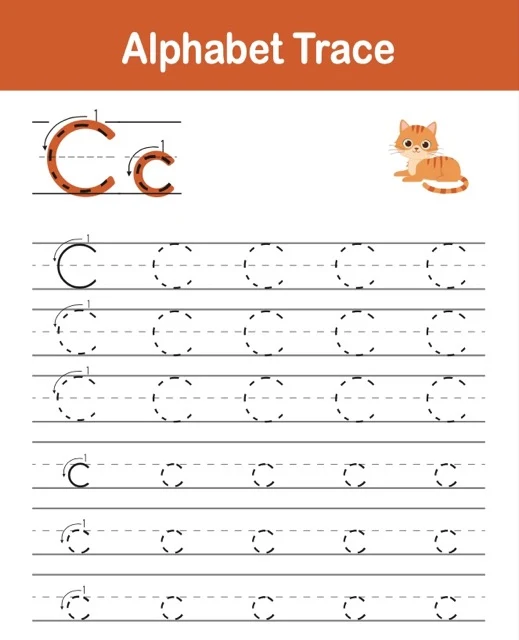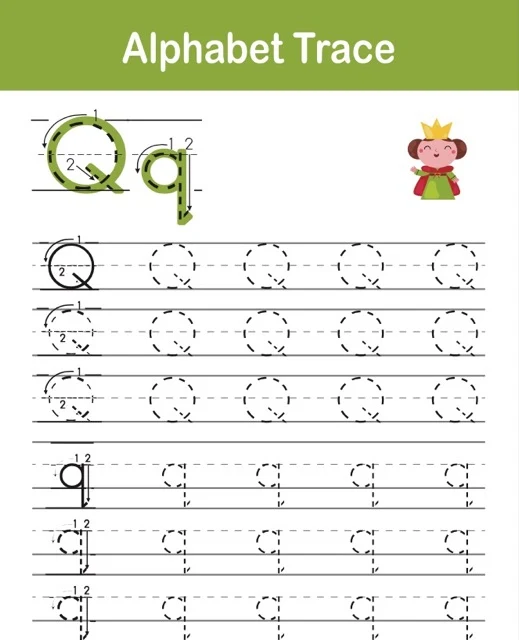Learn to Write Workbook
"Learn to Write.pdf" is a workbook designed to teach young children basic writing skills. It features numerous tracing exercises that guide children in practicing lines and curves of varying lengths and complexities. Sections focus on tracing simple shapes, then progress to tracing the uppercase and lowercase letters of the alphabet. Each letter has multiple tracing examples, and many pages include illustrations of animals to maintain children's engagement. The exercises aim to improve fine motor skills and prepare children for writing.
Learn to Write Workbook FAQ
"Learn to Write" Workbook: FAQ
1. What is the "Learn to Write" workbook?
"Learn to Write" is an educational workbook created to help young children develop fundamental writing skills.
2. What does the workbook focus on?
The workbook primarily focuses on tracing exercises. It guides children to practice different lines and curves, gradually increasing in length and complexity.
3. What kind of tracing exercises are included in the workbook?
The workbook starts with tracing simple shapes and then moves on to the uppercase and lowercase letters of the alphabet.
4. How does the workbook present the letter tracing?
Each letter of the alphabet has dedicated pages with multiple tracing examples. Each letter is broken down into numbered strokes, with arrows to show the direction of writing.
5. Does the workbook include any other elements besides tracing exercises?
Yes, many pages incorporate colorful illustrations of animals and everyday objects alongside the tracing exercises. These images are meant to keep children engaged and entertained while they learn.
6. What is the overall goal of the workbook?
The main objective of "Learn to Write" is to enhance a child's fine motor skills. By practicing tracing, children develop the hand-eye coordination and muscle control necessary for proper pencil grip and writing.
7. What age range is the "Learn to Write" workbook most appropriate for?
This workbook is best suited for preschool and kindergarten-aged children who are in the early stages of learning to write.
8. How can using this workbook benefit a child?
By using this workbook, children can:
●
Develop fine motor skills: Tracing helps strengthen the small muscles in their hands and fingers, improving their dexterity.
●
Learn letter formation: The tracing exercises help children understand the correct way to form each letter, both uppercase and lowercase.
●
Prepare for writing: The workbook serves as a stepping stone to writing, making the transition to independent letter writing smoother.
●
Build confidence: As children master tracing, they gain confidence in their abilities, encouraging them to continue learning and practicing.
Learn to Write Workbook Study Guide
"Learn to Write" Workbook Study Guide
Short Answer Quiz
1.
What is the primary focus of the "Learn to Write" workbook?
2.
How does the workbook progress in terms of tracing difficulty?
3.
What are the two main categories of tracing exercises in the workbook?
4.
Besides tracing, what other activity is included in the workbook to reinforce learning?
5.
How does the workbook engage children and keep them interested in the exercises?
6.
What is the intended age range for users of this workbook?
7.
Describe how the "Learn to Write" workbook helps children develop fine motor skills.
8.
How does the workbook aim to make the transition to independent writing easier for children?
9.
Besides improving dexterity, what other benefit does tracing offer in terms of letter recognition?
10.
Explain how using the workbook can boost a child's confidence in their writing abilities.
Short Answer Quiz Answer Key
1.
The primary focus of the "Learn to Write" workbook is tracing exercises designed to improve fine motor skills in young children.
2.
The workbook starts with tracing simple shapes and lines, then progresses to more complex curves and eventually focuses on tracing uppercase and lowercase letters.
3.
The workbook includes tracing exercises for basic shapes and for uppercase and lowercase letters of the alphabet.
4.
The "Help Animals Go Home" activity in the workbook requires children to trace paths that connect animals to their homes, combining tracing practice with a fun and engaging activity.
5.
The workbook uses colorful illustrations of animals alongside the tracing exercises to maintain children's interest and engagement.
6.
The "Learn to Write" workbook is most suitable for preschool and kindergarten-aged children, typically between the ages of 3 and 5.
7.
Tracing exercises in the workbook help strengthen the small muscles in children's hands and fingers, improving their dexterity and control necessary for holding a pencil and writing.
8.
By focusing on correct letter formation through repeated tracing, the workbook prepares children for independent letter writing, making the transition from tracing to writing on their own smoother.
9.
Tracing allows children to not only physically practice letter shapes but also to visually familiarize themselves with each letter's form, which aids in letter recognition.
10.
As children master the tracing exercises, they gain a sense of accomplishment, boosting their confidence in their ability to learn and practice writing skills. This positive reinforcement encourages continued learning.
Essay Questions
1.
Discuss the importance of developing fine motor skills in early childhood, particularly in relation to writing.
2.
Analyze the effectiveness of tracing as a method for teaching young children letter formation. Compare and contrast it with other methods of pre-writing instruction.
3.
Explain the role of visual aids and engaging activities in maintaining children's interest and motivation during learning. Using examples from the "Learn to Write" workbook, discuss how these elements can contribute to successful learning outcomes.
4.
Evaluate the "Learn to Write" workbook as a tool for preparing children for formal writing instruction. Consider its strengths and limitations, and suggest potential modifications or additions to enhance its effectiveness.
5.
Explore the connection between fine motor skill development and cognitive development in young children. Explain how activities like tracing can potentially influence both areas of development.
Glossary of Key Terms
Fine Motor Skills: The ability to use small muscles in the hands and fingers for precise movements, such as grasping, manipulating objects, and writing.
Tracing: The act of copying or following a pre-existing line or shape with a writing instrument.
Letter Formation: The process of correctly shaping letters of the alphabet.
Dexterity: Skill and ease in using one's hands.
Hand-Eye Coordination: The ability to synchronize movements of the hands and eyes to perform tasks.
Pencil Grip: The way a person holds a pencil, influencing writing control and comfort.
Preschool: An educational program for children aged 3-5, typically before they enter kindergarten.
Kindergarten: The first year of formal schooling, usually for children aged 5-6.
Visual Aids: Educational materials that use visual elements (pictures, illustrations, colors) to enhance learning and understanding.
Engaging Activities: Learning experiences that capture and hold a child's attention, fostering active participation and motivation.
Learn to Write Workbook Review
Briefing Doc: "Learn to Write" Workbook Review
Target Audience: Preschool and Kindergarten Children (ages 3-5)
Main Objective: Develop fine motor skills and prepare children for writing.
Workbook Content & Approach:
●
Tracing Exercises: The core of the workbook features a variety of tracing exercises.
○
Progression: Tracing begins with simple lines and curves, increasing in complexity. This culminates in tracing both uppercase and lowercase letters.
○
Letter Formation: Each letter has dedicated pages with multiple tracing examples. Letters are broken down into numbered strokes with directional arrows to guide proper formation ("Learn to Write Workbook FAQ").
○
Engaging Activities: The "Help Animals Go Home" activity uses tracing paths to connect animals to their homes, combining practice with a playful element ("Learn to Write Workbook Study Guide").
●
Visual Aids: Colorful illustrations of animals are integrated with tracing exercises to maintain children's interest ("Learn to Write Workbook Study Guide"). See examples from "Learn to Write.pdf" (pages featuring letters A-Z).
Benefits of Using the Workbook:
●
Fine Motor Skill Development: Tracing strengthens the small muscles in hands and fingers, enhancing dexterity, hand-eye coordination, and pencil grip. ("Learn to Write Workbook FAQ" & "Learn to Write Workbook Study Guide").
●
Letter Recognition and Formation: The workbook familiarizes children with letter shapes through visual and physical practice, aiding in letter recognition and correct formation. ("Learn to Write Workbook Study Guide").
●
Confidence Building: Mastering tracing exercises leads to a sense of accomplishment, boosting children's confidence in their writing abilities and encouraging continued learning. ("Learn to Write Workbook Study Guide").
●
Preparation for Formal Writing: "The workbook serves as a stepping stone to writing, making the transition to independent letter writing smoother." ("Learn to Write Workbook FAQ").
Examples of Tracing Exercises ("Learn to Write.pdf"):
●
Lines to Trace: Features vertical, horizontal, and diagonal lines of varying lengths, all with directional arrows for guidance.
●
Curves to Trace: Includes various curves like semi-circles, C-shapes, reverse C-shapes, and circles, again with directional arrows.
●
Longer Lines and Curves: Presents more intricate patterns involving a combination of lines and curves that further challenge fine motor control.
Potential Enhancements:
●
Variety of Activities: While tracing is essential, incorporating other pre-writing activities like drawing, coloring, and connecting dots could provide a more well-rounded approach.
●
Personalized Feedback: Including sections for children to practice free-hand writing after tracing would allow for personalized feedback and tracking progress.
Overall Evaluation:
The "Learn to Write" Workbook is a valuable tool for developing fine motor skills and introducing young children to writing. Its systematic approach, visual appeal, and engaging activities make it effective in achieving its objectives. However, incorporating additional pre-writing activities and personalized feedback mechanisms could further enhance its efficacy.































